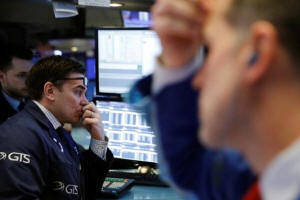Earnings boost for stocks may lose luster with rising
yields
 Send a link to a friend
Send a link to a friend
 [March 03, 2018]
By Lewis Krauskopf [March 03, 2018]
By Lewis Krauskopf
NEW YORK (Reuters) - There is little doubt
on Wall Street that U.S. corporate profits are on track to rise at a
healthy rate this year, with an overall estimate for growth of almost 20
percent.
Less certain, however, is how investors should value those profits with
price-to-earnings estimates. The struggle to do so could lead to more
stock market volatility.
The valuations issue has gained fresh prominence for market strategists
amid a rise in interest rates and bond yields, along with concerns about
inflation increasing.
Those factors, including a yield on the benchmark 10-year U.S. Treasury
note <US10YT=RR> that is approaching 3 percent, has prompted investors
to rethink how to price stocks, which have become more expensive as the
nearly nine-year bull market has aged.
Indeed, some investors are weighing whether equities deserve lower
valuations.

"It’s a topic that’s got to be in the front of a lot of asset managers'
minds right now: What level is this market a really good buy again?,"
said Jim Paulsen, chief investment strategist at The Leuthold Group in
Minneapolis.
"We are going to get good earnings coming through," Paulsen said. "The
problem is we are going to lose the value on those earnings."
A test for equity valuations could come with next Friday's U.S.
employment report for February. Last month's report revealed surprising
wage gains that sparked concerns of inflation, in turn setting off a
jump in yields and a drop in stocks.
Stocks are commonly valued by comparing their price to their estimated
profits over the next year, known as the price-to-earnings, or P/E,
ratio.
“Interest rates set the discount for what you want to value companies at
and in general with higher interest rates you are going to see lower
P/Es as fair value,” said Rick Meckler, president of LibertyView Capital
Management in Jersey City, New Jersey. "You are going to be less willing
to pay higher multiples on stocks where your discount rate continues to
go up."
VOLATILITY
The P/E ratio on the benchmark S&P 500 index <.SPX> had climbed to 18.6
times by the end of January, the highest level in about 15 years,
according to Thomson Reuters Datastream, as stocks climbed to all-time
peaks.
That was just before the market plunged at the start of February,
dropping 10 percent and confirming a correction, and in turn lowering
the P/E ratio to 17 times earnings estimates.

Valuations hovered around that level at the end of a turbulent week. The
S&P 500 rose 0.5 percent on Friday, recovering some losses from
Thursday, when U.S. President Donald Trump announced plans for tariffs
on steel and aluminum, raising concern about higher prices and a trade
war. [.N]
[to top of second column] |

Traders work on the floor of the New York Stock Exchange shortly
after the opening bell in New York, U.S., March 1, 2018.
REUTERS/Lucas Jackson

"A lot of the volatility that has occurred and a bit of the repricing of
financial assets, stocks in particular, is a result of there (being) a little
bit of uncertainty as to what we should use as that discount rate," said Michael
Arone, chief investment strategist at State Street Global Advisors in Boston.
Half of the S&P 500's returns last year stemmed from the P/E going up -
investors willing to pay more for future earnings - helped by optimism about the
global economy, according to Arone, but people’s willingness to "pay even more
for those earnings is probably beginning to fade."
The good news for stock investors is that S&P 500 earnings are expected to jump
19.2 percent in 2018, the biggest increase since a 40.3 percent rise in 2010, as
the United States emerged from the financial crisis, according to Thomson
Reuters I/B/E/S.
An examination of the six other years in which S&P 500 earnings growth topped 15
percent, along with increasing 10-year Treasury yields and the Federal Reserve
raising interest rates, found that P/E multiples shrank in all but one year, but
the index still managed gains, according to Keith Lerner, chief market
strategist with SunTrust Advisory Services in Atlanta.
Lerner expects the stock market will be able to maintain a forward P/E of around
16 times. That is cheaper than current levels, but above the S&P 500's long-term
average of 15 times, according to Datastream.
According to a Reuters poll of market strategists this week, stocks will rack up
a gain of more than 8 percent for the year, despite the recent correction.

"We are not relying on multiple expansion. In fact, if rates continue to rise
like this, we are looking at probably a little bit more of a contraction
scenario," said Mona Mahajan, U.S. investment strategist at Allianz Global
Investors. "But this will be offset by strong (earnings) growth."
But Paulsen said he believed stocks may be overpriced and that Leuthold recently
reduced U.S. equity exposure in its main funds. Among his concerns was whether
inflation is about to rise more sharply.
“We have given birth to a whole new generation of investors that have rarely
seen inflation at even 3 percent,” Paulsen said.
"If you are going to generate some negative fallout from additional growth,
however much longer this recovery lasts, that creates a very different
environment."
(Editing by Alden Bentley, Bernadette Baum and James Dalgleish)
[© 2018 Thomson Reuters. All rights
reserved.] Copyright 2018 Reuters. All rights reserved. This material may not be published,
broadcast, rewritten or redistributed.
Thompson Reuters is solely responsible for this content. |